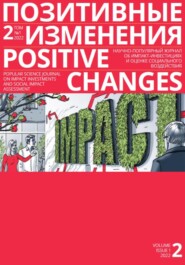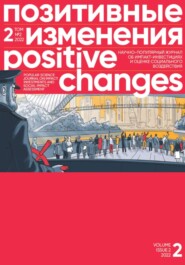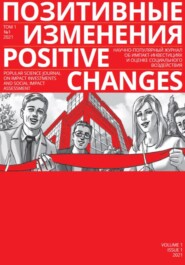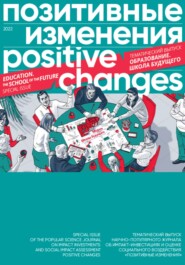По всем вопросам обращайтесь на: info@litportal.ru
(©) 2003-2025.
✖
Позитивные изменения. Города будущего. Тематический выпуск, 2022 / Positive changes. The cities of the future. Special issue, 2022
Настройки чтения
Размер шрифта
Высота строк
Поля
Сегодня для всех, кто занимается тематикой городского, регионального, пространственного развития очевидно растущее несоответствие «повестки будущего» и «повестки настоящего». Это несоответствие существовало и раньше, мы в Школе Управления СКОЛКОВО регулярно его наблюдали, работая с командами региональных и муниципальных администраций. Мы видели, что концепции «устойчивого развития», «смены технологического уклада», «энергоперехода» на муниципальном уровне гораздо менее интегрированы. В ходе проектной работы на программе становилось очевидно, что дело не в непонимании терминов – как раз в терминах любой госслужащий ориентируется достаточно неплохо. Дело в дистанции между терминологией федеральных экспертов и реальностью регионального и муниципального управления. Грубо говоря, авария на котельной ограничивала темпы энергоперехода, а действия контролирующих органов способствовали наступлению сингулярности, но вовсе не в понимании автора этого термина Реймонда Курцвейла.
До 2022 года эта дистанция была функциональной: играла роль стимула для развития, была полезным инструментом обнаружения проблем. Во многом для этого и существуют образовательные программы – чтобы «вытаскивать» менеджеров из повседневной бюрократической рутины и «обновлять прошивку» управленческих навыков.
По состоянию на октябрь 2022 года «повестка развития» продолжает по инерции частично существовать на уровне целеполагания федеральных органов власти, однако на региональном и муниципальном уровне несравнимо более актуальной становится «повестка удержания стабильности». Можно перечислить темы, которые чаще всего упоминались в ходе интервью в октябре 2022 года и сравнить их с ключевыми темами итоговых проектов на программе для городских команд в октябре 2021 года.
Разумеется, сравнение в вышеуказанной таблице нельзя считать «научно обоснованным»: мы сравниваем ситуацию публичной защиты городских проектов в рамках сколковской программы «при начальниках» и ситуацию участия в интервью. Очевидно, что во второй ситуации мэры как респонденты готовы к несколько более откровенному перечислению проблем. Вместе с тем, переоценивать этот фактор не следует: обобщенная готовность к высказыванию любого мнения, отличного от официального, радикально снизилась за год, особенно для госслужащих. Поэтому на основе сравнения мы выдвигаем гипотезу о постепенном замещении «повестки развития» «повесткой стабильности».
ГИПОТЕЗА 2: МУНИЦИПАЛЬНЫЙ УРОВЕНЬ УПРАВЛЕНИЯ НАХОДИТСЯ В АВАНГАРДЕ «ПЕРЕСБОРКИ ОБЩЕСТВЕННОГО ДОГОВОРА»
Одним из наиболее интересных «инсайтов», полученных в ходе интервью, было упоминание одним из глав администраций «запроса на новую редакцию общественного договора» (практически дословная цитата). Аргументы респондента были следующими. Повышение требований со стороны государства к населению[31 - Мобилизация не была названа напрямую, однако из общего контекста можно сделать вывод, что речь шла в том числе о «перегибах» в ходе проведения мобилизации.] накладывает дополнительные обязательства на муниципалитеты как на наиболее «близкий к народу» уровень государственной власти.
Эта тенденция наиболее заметна в малых городах, где сотрудников городской администрации часто «знают в лицо» (говоря социологическим языком – существенно ниже «дистанция власти»[32 - Понятие дистанции власти (power distance) введено в научный оборот в результате исследований по типологии культурных измерений социального психолога Г. Хофстеде. Является одной из ключевых характеристик организационной культуры того или иного общества. Чем выше дистанция власти, тем выше склонность подчиненных или населения принимать решения любого из уровней иерархии.]). При нарастании кризисных явлений в экономике и социальной сфере дистанция власти в отношении муниципального уровня управления будет снижаться значительно быстрее, чем в отношении федеральной власти. Как следствие, муниципальным властям придется оперативнее реагировать на новые запросы со стороны горожан. Этот процесс может стать одним из определяющих для формирования городской «повестки» в ближайшие годы.
Муниципальным властям придется оперативнее реагировать на новые запросы со стороны горожан. Этот процесс может стать одним из определяющих для формирования городской «повестки» в ближайшие годы.
Приведем высказывание одного из мэров малых городов (население менее 50 тысяч человек): «В последний месяц люди на улице стали гораздо чаще останавливать и даже не просить помощи, а почти требовать объяснить происходящее, и никто не хочет слышать, что решения принимаются в Москве, а мы только исполнители». Как уже было сказано, на базе 10 интервью невозможно оценить, насколько распространенным является увеличение «спроса» со стороны населения на прямую коммуникацию и формулирование новых социальных гарантий. Однако, в качестве исследовательской гипотезы можем предположить, что такой процесс начнется не с мегаполисов, где уровень притязаний горожан итак достаточно высокий, а с малых городов – именно в силу более низкой дистанции власти.
Отметим, что все усилия федерального центра в предыдущие годы были направлены на повышение подотчетности муниципальных администраций центральной «вертикали»[33 - Последний наиболее характерный пример институционального закрепления ограничений управленческой самостоятельности муниципальных органов и местного самоуправления – Закон о публичной власти, принятый в декабре 2021 года.]. События 2022 года могут стать неожиданным триггером изменения сложившегося тренда. Проще говоря, сотрудники администраций малых и средних городов будут вынуждены искать новый баланс между растущим «прессингом» с двух сторон – как традиционным со стороны федерального и регионального уровней, так и относительно новым – со стороны части городского населения, испытывающего тревожность в отношении безопасности и перспектив социальной стабильности.
В качестве исследовательской гипотезы можем предположить, что «спрос» со стороны населения на прямую коммуникацию с представителями власти начнется не с мегаполисов, а с малых городов.
Интервью с главами муниципалитетов проводились в первой половине октября, то есть после объявления мобилизации, но до указа Президента России о введении специальных режимов (средний уровень реагирования и повышенный уровень готовности) и формировании оперативных штабов под руководством глав регионов. Можно предположить, что эти административные нововведения также скажутся на уровне дистанции власти. Безусловно, механизмы имплементации Указа Президента и реакция населения могут значительно различаться в зависимости от географического положения (например, южные области ЦФО) или социально-экономической ситуации (национальные республики). В любом случае, весьма вероятно, что именно представители муниципального уровня управления и через некоторое время регионального уровня управления будут вынуждены массово реагировать на запрос по «переоформлению общественного договора».
Если год назад в основе «общественного договора» на муниципальном уровне в первую очередь были вопросы благоустройства и инфраструктурного развития (в том числе связанные со строительством и ремонтом объектов социальной сферы, но не только с ними), то в настоящее время содержание «договора» может измениться. Отталкиваясь от проведенных интервью, мы можем предположить что основным содержанием станет обеспечение социальной стабильности, по крайней мере в той степени, в которой это возможно с учетом ограниченных ресурсов на уровне муниципалитетов. Позволим себе даже более смелое обобщение, в некотором смысле, соединяющее две предложенные нами гипотезы. В 2021 году, как и в целом в предыдущее десятилетие, образ будущего российских городов (упомянутая нами выше «повестка развития») определялся почти исключительно тенденциями и инновациями, происходящими в Москве и других мегаполисах (например, цифровизация транспортной системы или создание креативных кластеров). Есть достаточно высокая вероятность, что образ будущего российских городов после 2022 года будет во многом зависеть от той «пересборки» общественного договора, первые признаки которой мы обнаружили в ходе недавних интервью.
Есть достаточно высокая вероятность, что образ будущего российских городов после 2022 года будет во многом зависеть от «пересборки» общественного договора.
ПРАКТИЧЕСКИЕ ВЫВОДЫ И ПЛАНЫ ПО ПРОДОЛЖЕНИЮ ИССЛЕДОВАНИЯ
Возвращаясь к центральному тезису и названию статьи, попробуем сделать некоторые промежуточные выводы относительно изменения образа будущего для российских городов. Справедливо ли говорить, что «повестка развития» исчезает и, следовательно, для руководителей муниципалитетов (а возможно вслед за ними и региональных органов власти) вопросы долгосрочного прогнозирования перестают быть актуальными? Разумеется, нет.
С нашей точки зрения, ключевой интеллектуальный вызов текущего момента для любых специалистов по городскому, региональному и пространственному развитию можно разделить на две основные задачи:
1) Типологизация городов (а возможно и регионов) с точки зрения перспектив сохранения экономической устойчивости, в частности, рынка труда. В особенности, это касается малых и средних городов: например, логично предположить, что города, в которых ключевой отраслью является автомобильная промышленность (Всеволожск, Калуга, Набережные Челны, Тольятти) имеют меньшую устойчивость, чем города с оборонной промышленностью (Ижевск, Комсомольск-на-Амуре, Северодвинск, Тула и другие). Приоритеты программ поддержки городов могут корректироваться в зависимости от этого «прогноза устойчивости» и помимо традиционных федеральных стейкхолдеров (Минэкономразвития, ВЭБ.РФ, Аналитический центр при Правительстве РФ) в этот процесс должны быть вовлечены также Минпромторг, Минтруд и другие.
2) В тесном взаимодействии с главами администраций (которые в свою очередь находятся в непосредственном контакте с населением городов) определение потенциальных параметров «обновленного общественного договора на муниципальном уровне». Должно происходить регулярное определение приоритетных зон внимания в социальной сфере (поддержка нуждающихся, здравоохранение, контроль устойчивости объектов социальной инфраструктуры).
Муниципальный уровень в новой ситуации должен иметь возможность больше непосредственного и весомого влияния на распределение бюджетных потоков, именно в силу лучшего понимания потребностей населения. Нужно признать, что в условиях текущих законодательных и институциональных ограничений в настоящий момент муниципальный уровень не имеет достаточных рычагов и именно это является одним из ключевых элементов «образа будущего российских городов», который потребует пересмотра в ближайшее время.
How Obsolete is Our Future? Hypotheses About Changes in Municipal Management Priorities
The image of the future is not something permanent. This is especially evident these days in Russia, where conditions for urban development have changed dramatically over the past year. It is all the more important to observe changes and draw conclusions at exactly the moment when tectonic shifts are taking place in all spheres of life and activity in society. A study conducted by the SKOLKOVO School of Management is devoted to analyzing and fixing such a "moment" in the space of municipal management.
Alexey Gusev
Head of Public Sector Analytics, SKOLKOVO School of Management
Vitaly Kunashko
Analyst, Moscow School of Management SKOLKOVO
In the fall of 2021, we at the SKOLKOVO School of Management completed a training program for teams from the 100 largest cities in Russia. It was the largest training program in the country for municipal-level managers. Mayors presented their projects in the field of sustainable development, new industries, infrastructure and landscaping before governors and heads of federal agencies. These projects are a "replica" of the image of the future that we, together with the city teams, have been able to develop as a result of long and often tedious work.
Exactly one year has passed since then, and in this period the external context has changed more drastically than one could have ever imagined. Metaphorically speaking, our vision of the future has managed to turn obsolete several times. Therefore, in designing a new program for city teams, we decided to conduct an extra mini-study, in addition to the formal monitoring of the last year’s projects – a series of interviews with mayors and other participants of the last year’s program. The interview sampling included cities from the Central, Volga and Ural districts, regional centers, small and medium-sized towns. Of course, 10 heads of municipalities is not a representative sample by far, so within this text we will formulate several research hypotheses, which have yet to be tested as part of the continuation of our study, as well as directly in the dynamic public process. It seems important to record these hypotheses as a "fingerprint" of the new times, a reference point to which we can look back from the future to verify our predictions.
HYPOTHESIS 1: AT THE LEVEL OF THE MUNICIPAL BUREAUCRACY, THE DEVELOPMENT AGENDA IS REPLACED BY THE AGENDA OF MAINTAINING STABILITY
Today, it is obvious to everyone involved in urban, regional, and spatial development that there is a growing discrepancy between the "agenda of the future" and the "agenda of the present." This discrepancy existed before, and we at SKOLKOVO School of Management have regularly observed it, working with teams of regional and municipal administrations. We have seen that the concepts of "sustainable development," "technological change," and "energy transition" are much less integrated at the municipal level. In the course of the project work on the program, it became clear that it was not a matter of misunderstanding the terms – in fact, any civil servant knows the terms quite well. The point is the gap between the vocabulary used by the federal experts and the reality of regional and municipal management. Roughly speaking, an accident at the boiler plant limited the pace of energy transition, and the actions of the regulatory agencies contributed to the singularity, but not the way it was understood by the author of the term, Raymond Kurzweil.
Before 2022, this distance was functional: it played the role of a stimulus for development and was a useful tool for detecting problems. This is largely why educational programs exist – to "pull" managers out of the day-to-day bureaucratic grind and "update the firmware" of their managerial skills.
As of October 2022, the "development agenda" continues to exist by inertia partially at the level of federal government goal-setting, but the "agenda of maintaining stability" is becoming incomparably more relevant at the regional and municipal level. We can list the themes that were most frequently mentioned in the October 2022 interviews and compare them to the key themes of the final projects at the October 2021 program for city teams.
Of course, the comparison in the above table cannot be considered "scientifically valid": we are comparing a public presentation of urban development projects under the SKOLKOVO program "in front of the big bosses" vs a participation in interviews. Obviously, in the second situation, mayors as respondents are somewhat more forthright in listing the problems. At the same time, this factor should not be overestimated: the generalized readiness to express any opinion that differs from the official one has declined radically over the year, especially for state employees. Therefore, based on the comparison, we hypothesize the gradual replacement of the "development agenda" with the "agenda of stability."
HYPOTHESIS 2: MUNICIPAL LEVEL OF MANAGEMENT IS IN THE VANGUARD OF "REASSEMBLING THE SOCIAL CONTRACT"
One of the most interesting insights from the interview was the "demand for a new version of the social contract" mentioned by one of the administration heads (almost a verbatim quote). The respondent’s reasoning was as follows. Increasing the state’s demands to the population[34 - Mobilization was not named directly; however, from the general context, we can conclude that there were, among other things, "excesses" during the mobilization.] imposes additional obligations on the municipalities as the level of government, as being "the closest to the people."
This trend is most noticeable in small towns, where employees of the city administration are often "known by sight" (sociologically speaking, the "power distance" is significantly lower[35 - The concept of power distance was introduced as a result of research on the typology of cultural dimensions by the social psychologist G. Hofstede. It is one of the key characteristics of the organizational culture of a society. The higher the power distance, the higher the propensity of subordinates or the population to make decisions at any level of the hierarchy.]). As economic and social crises intensify, the power distance with respect to the municipal level of government will decrease much faster than with respect to the federal government. As a consequence, municipal authorities will have to respond more quickly to new requests from the citizens. This may become one of the defining processes in the formation of the city’s "agenda" for the years to come.
Municipal authorities will have to respond more quickly to new requests from the citizens. This may become one of the defining processes in the formation of the city’s "agenda" for the years to come.
Here is a statement by one of the small-town mayors (population under 50,000): "In the last month, people in the streets have been stopping me much more often and not even asking for help, but almost demanding to explain what is happening, and no one wants to hear that decisions are made in Moscow and that we are only the implementers." As mentioned above, it is impossible to assess how widespread the increase in "demand" from the population for direct communication and the formulation of new social guarantees is, based on just 10 interviews. However, as a research hypothesis, we can assume that such a process will begin not in megacities, where the citizen’s claims are already quite high, but in small towns – precisely because of the lower power distance.
It should be noted that all the federal center’s efforts in previous years were aimed at increasing the accountability of municipal administrations to the central authorities[36 - The last and the most typical example of institutionalization of restrictions on the managerial autonomy of municipal bodies and local self-government is the Law on Public Authorities, adopted in December 2021.]. The events of 2022 could be an unexpected trigger to change the established trend. Simply put, employees of small and medium-sized city administrations will have to find a new balance between the growing "pressure" from two sides – both traditional on the federal and regional levels, and relatively new on the part of the urban population, which has anxieties about security and prospects for social stability.
As a research hypothesis, we can assume that "demand" from the population for direct communication with government representatives will begin not in megacities, but in small towns.
Interviews with heads of municipalities were conducted in the first half of October, that is, after the announcement of mobilization, but before the President of Russia issued a decree introducing special security regimes (medium level of response and high level of readiness) and formation of field staffs under the leadership of the heads of regions. It can be assumed that these administrative innovations will also affect the level of power distance. Of course, the mechanisms of implementation of the Presidential Decree and the reaction of the population may vary greatly depending on the geographical location (for example, the southern regions of the Central Federal District) or the socio-economic situation (the national republics). In any case, it is very likely that it will be representatives of the municipal level of government and, after some time, of the regional level of government who will be forced to respond en masse to the request to "rewrite the social contract."
While a year ago the "social contract" at the municipal level was based primarily on issues of improvement and infrastructure development (including, but not limited to, the construction and repair of social facilities), now its content may change. Based on the interviews conducted, we can assume that the main content will be to ensure social stability, at least to the extent that this is possible given the limited resources at the level of municipalities. Let us allow ourselves an even bolder generalization connecting, in a sense, the two hypotheses we have proposed. In 2021, as in the whole of the previous decade, the image of the future of Russian cities (the "development agenda" mentioned above) was determined almost exclusively by trends and innovations taking place in Moscow and other megacities (for example, the digitalization of the transport system or the formation of creative clusters). There is a fairly high probability that the image of the future of Russian cities after 2022 will largely depend on the "reassembly" of the social contract, the first signs of which we found in recent interviews.
There is a fairly high probability that the image of the future of Russian cities after 2022 will largely depend on the "reassembly" of the social contract.
PRACTICAL CONCLUSIONS AND PLANS FOR THE CONTINUATION OF THE STUDY
Returning to the central thesis and the title of the article, let us try to draw some intermediate conclusions about the changing image of the future for Russian cities. Is it fair to say that the "development agenda" is disappearing and, consequently, for the heads of municipalities (and perhaps after them, regional authorities) the issues of long-term forecasting are becoming less relevant? Of course not.
From our point of view, the key intellectual challenge of the moment for any specialists in urban, regional and spatial development can be divided into two main tasks:
1) Classification of cities (and possibly regions) in terms of prospects for maintaining economic sustainability, particularly in the labor market. This is especially true for small and medium-sized cities: for example, it is logical to assume that cities where the key industry is the automotive industry (Vsevolozhsk, Kaluga, Naberezhnye Chelny, Togliatti) have less sustainability than cities with a defense industry (Izhevsk, Komsomolsk-on-Amur, Severodvinsk, Tula, and others). Priorities of the city support programs can be adjusted depending on this "sustainability forecast" and in addition to traditional federal stakeholders (Ministry of Economic Development, VEB.RF, the Analytical Center under the Government of the Russian Federation); the Ministry of Industry and Trade, the Ministry of Labor and others should also be involved in this process.
2) Determining the potential parameters of a "renewed social contract at the municipal level" in close cooperation with the heads of administrations (who, in turn, are in direct contact with the population of the cities). There should be regular identification of priority areas of attention in the social sphere (support for the needy, health care, control of the sustainability of social infrastructure facilities).
The municipal level in the new situation should be able to have more direct and significant influence on the distribution of budgetary flows, precisely because of a better understanding of the needs of the population. We must recognize that, under the current legislative and institutional constraints, the municipal level currently has insufficient leverage, and this is one of the key elements of the "image of the future of Russian cities," which will require revision in the near future.
Город будущего как объект исследования. 10 современных книг









